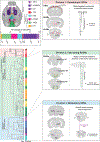From thought to action: The organization of spinal projecting neurons
- PMID: 40818073
- PMCID: PMC12410837
- DOI: 10.1016/j.celrep.2025.116153
From thought to action: The organization of spinal projecting neurons
Abstract
Spinal projecting neurons (SPNs) are specialized neurons with cell bodies residing in the brain and axons extending into the spinal cord, providing a direct communication pathway that enables top-down control of nearly every bodily function. Disruptions to these pathways contribute to a wide range of neurological disorders, including developmental, degenerative, and traumatic pathologies. Advances in retrograde labeling, activity monitoring, and circuit manipulation have enabled increasingly precise and comprehensive characterizations of SPNs. Here, we provide a historical overview of brain-spinal cord connectivity research, followed by an in-depth synthesis of the current knowledge of SPN anatomical connections, molecular identities, and functional properties. We then propose a conceptual framework in which distinct SPN modules coordinately regulate motor, autonomic, and sensory processes to support bodily readiness and drive behavioral action. Beyond revealing the organizational logic of SPNs, these insights provide a foundation for designing therapies to restore brain-spinal cord communication following injury or disease.
Keywords: CP: Neuroscience; descending control; spinal cord; spinal cord injury.
Copyright © 2025 The Author(s). Published by Elsevier Inc. All rights reserved.
Conflict of interest statement
Declaration of interests Z.H. is a co-founder of Rugen and Myrobalan and an advisor of Axonis.
Figures




References
Publication types
MeSH terms
Grants and funding
LinkOut - more resources
Full Text Sources
Miscellaneous

